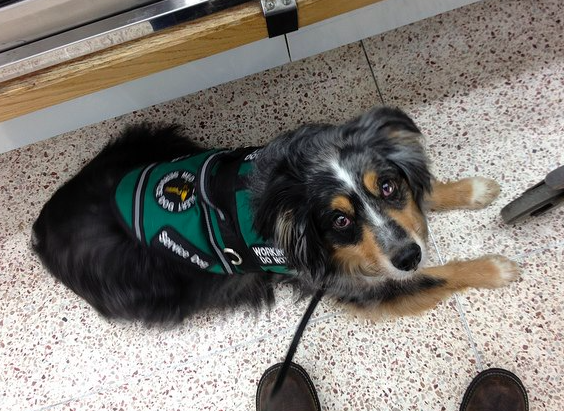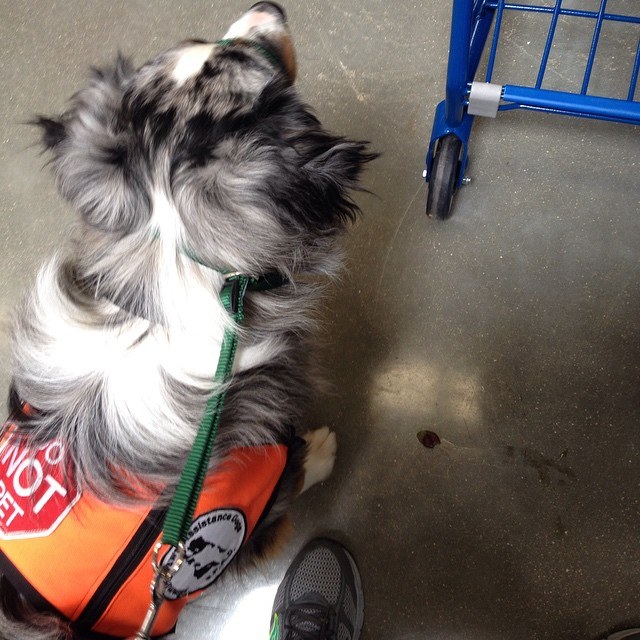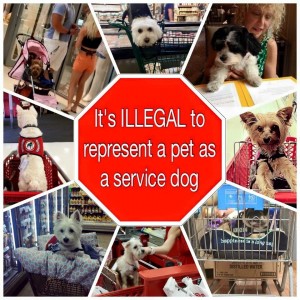Stop Faking Service Dogs
Loving your pet too much is putting people with real disabilities at risk
Here in famously pet-friendly Los Angeles, I encounter dogs that are blatantly not service animals on a daily basis. Recently, during a morning visit to my local café, I laughed when a woman whose tiny dog was thrashing around at the limits of its leash and barking fiercely at other customers loudly proclaimed that it was a service animal. “It’s my service dog,” she said to me, scowling. “You’re not allowed to ask me why I need it!”
Data backs my anecdote up. A study conducted at the University of California at Davis found that the number of “therapy dogs” or “emotional support animals” registered by animal control facilities in the state increased 1,000 percent between 2002 and 2012. In 2014, a supposed service dog caused a U.S. Airways flight to make an emergency landing after repeatedly defecating in the aisle. A Google News search for “fake service dog” returns more than 2.2 million results.
This has recently led state governments to try and curb the problem through law. In Massachusetts, a House bill seeks to apply a $500 fine to pet owners who even falsely imply that their animal may be a service dog. In California, the penalty is $1,000 and up to six months in jail. Twelve states now have laws criminalizing the misrepresentation of a pet as a service animal. That’s good, but with all the confusion surrounding what a service dog actually is, there’s less and less protection for their unique status.
A new bill introduced to the Senate this summer by Wisconsin Democrat Tammy Baldwin threatens to add to the confusion even more. If it becomes law, you’ll be able to take any animal on a plane simply by telling the airline that it’s an ESA. Alarmingly, the bill seems to include ESAs in its definition of service animals.
Look, I get the desire to bring your pet along with you everywhere you go. My dogs are as important to me as my friends and family. The first criteria my girlfriend and I apply to where we eat, drink, and travel is whether our dogs can enjoy it with us. But out of respect for the needs of disabled people, for the incredible work that real service dogs perform, and for the people managing and patronizing these businesses, we will not lie. We do not take our pets places where they’re not welcome. We never want to compromise the ability of a service dog to perform its essential duties.
As an animal lover, don’t you want the same thing?
What’s a Service Animal?
The Americans with Disabilities Act limits the definition of a service animal to one that is trained to perform “work or tasks” in the aid of a disabled person. So, while a dog that is trained to calm a person suffering an anxiety attack due to post-traumatic stress disorder is considered a service dog, a dog whose mere presence calms a person is not. The act states, “dogs whose sole function is to provide comfort or emotional support do not qualify as service animals under the ADA.”
That same law makes no requirements or provisions for any registration, licensing, or documentation of service animals. It also prohibits businesses or individuals from asking a disabled person for proof that their dog is a service animal. In fact, the ADA permits only two questions to be asked of people with service animals: Is the dog a service animal required because of a disability? What task is the dog trained to perform? That’s it. No inquiry can be made about the nature of the disability and no proof can be requested, nor are there any licenses or documents to prove a dog is a service animal.
Emotional support animals (let’s just use that as a catchall for any dog that provides comfort but does not perform a specific task) are specifically excluded by the ADA, and access for them is not provided by that law. Businesses and similar entities are left to define their own policies. Amtrak, for instance, does not consider ESAs to be service animals and does not permit them to ride in passenger areas on its trains.
Because ESAs provide benefit by their mere presence, there’s no burden of training for them like there is for a service dog. The presence of untrained, or poorly trained dogs in public places, and on crowded airplanes can lead to significant problems. In June, an ESA aboard an airplane attacked the human seated next to it, resulting in severe injury.
So where’s the confusion come from, and why are there so many pets on airplanes these days? The Air Carrier Access Act (ACAA) does recognize ESAs and mandates that they be allowed on planes. It also goes further to place a burden of proof on owners of both service animals and ESAs.
The Impact Pets Have on Service Dogs
“Another dog once spent an entire flight barking at my dog,” relates Randy Pierce, who’s been totally blind for the past 17 years. “My dog was not barking back, but the barking was changing her behavior. That makes it harder for her to do her job; she loses her focus. I’m 6’4″, so if she loses her focus, it means I’m going to hit my head on an exit sign or a doorway or, if we’re on a street, maybe even step out into traffic.”
I also spoke with my friend Kent Kunitsugu, whose 12-year-old son, Hayden, suffers from epileptic seizures. Their dog, Lola, is trained to smell the sweat associated with an oncoming seizure, alert Hayden and his parents, and then lay across him during a seizure to comfort and protect him. “We often have to ask people to get their pets away from ours, because it’s a distraction, and the dog needs to pay full attention to my son,” explains Kunitsugu. “People think we’re being assholes, but we can’t afford a distraction.”
Pierce’s dog, Autumn, completely ignores other dogs, doesn’t beg for food, sits quietly for the duration of long flights, and generally minimizes her impact. That’s the result of lots of money—service dogs cost upwards of $20,000—and thousands of hours of training. Pierce, for example, has developed a routine with Autumn that involves the dog communicating when she needs to go to the bathroom, and then doing so in a specific orientation to Pierce that enables him to easily find it and collect it in a baggie. A true service dog is essential to its human partner’s well being, as well as a huge financial investment that other untrained dogs in public places put at risk.
The increasing presence of ESAs on flights, and in businesses has also combined with confusion around the law to create a backlash that’s impacting true service dogs, in addition to pets.
“On that flight, I overheard the flight attendant remark to her colleague that she wished they wouldn’t allow service dogs,” describes Pierce. His disability is obvious, but that’s not always the case for people who need service dogs, and those with disabilities already find going out in public difficult and intimidating. Fake service dogs are giving real ones a bad reputation.
Quantifying Fake
You can order service dog vests, tags, harnesses and other paraphernalia on Amazon and countless other websites. Dozens of websites and services claim to offer registry, certification, licenses, or other documentation for service dogs—all scams, as the ADA neither defines or requires any such proof.
To take your emotional support animal on an airplane, all you need is a letter from a licensed mental health professional that’s on letterhead, signed, and less than a year old. You can buy those online for a few bucks: news investigations have found psychologists offering to sell them to otherwise undiagnosed clients. Heck, most of us could probably counterfeit one using Photoshop.
“In order to be a service dog, that dog has to be trained to perform a task, and there has to be a recognized disability,” explains Pierce. “I’ve met a lot of people who tell me this is their emotional support animal, but what they’ve just told me is they don’t understand the law.”
Pierce is frustrated that the law is so vague, often misunderstood, and simply used as an excuse to bring pets somewhere they don’t belong. Because you can only ask if a person with a service dog has a disability and what tasks the dog is trained to perform, most businesses and other services simply don’t question service dogs at all. And most people with emotional support animals don’t realize that their pets aren’t actually guaranteed equal access by the ADA, or any other law, outside of air travel.
Really the only mechanism available to legitimate service dog owners is to sue a business that denies them access, which just worsens the problem. “The owners of most places are intimidated,” says Pierce. “They don’t want a lawsuit on their hands for being wrong, and they don’t know what their rights are, so they don’t ask questions.”
Animal Lovers Must Unite
We find ourselves in a society that requires you to present a diagnosis of mental illness (or soon, just a verbal claim of such) if you want to safely fly with your dog. The system is broken.
In 2014, 25,000 emotional support animals boarded Jet Blue flights alone. Why isn’t there an airline that offers safe transport for pets? Or specific pet-friendly flights on certain popular routes?
And why aren’t there more dog-friendly restaurants, bars, music venues, and other businesses? There are nearly 90 million pet dogs in this country. That’s a huge market, but also a huge problem when us owners act inappropriately. As animal lovers, creating and supporting dog-friendly businesses should be our priority. Acting selfishly to the detriment of others will not create a more dog-friendly future. We want to be able to take our dogs to more places, more often, but we have to make sure doing so is appropriate and doesn’t infringe on the rights and well-being of people who need real service dogs.
The American Kennel Club offers a Canine Good Citizen certification after a formal process of testing and training good behavior. If you want to bring your dog into a café, why aren’t you being asked to produce evidence of that, rather than falsely stating that the business owner has to permit your emotional support animal?
“Instead of looking at ourselves as service dog users and faux service dog users, I like to think of all of us as dog lovers,” says Pierce. “When you look at it from that perspective, they’re not mutually exclusive. How do we make sure all our animals are able to succeed?”
Link to the original article:
https://www.outsideonline.com/2236871/stop-faking-service-dogs?utm_source=facebook&utm_medium=social&utm_campaign=facebookpost


 Liz’s service dog Mac
Liz’s service dog Mac Liz’s service dog in training, Linc
Liz’s service dog in training, Linc